Brian Meert's Blog, page 82
July 8, 2019
Facebook Updates Terms of Service for Better Clarity and Transparency

Jul. 8, 2019
 Image Courtesy of Pixabay
Image Courtesy of PixabayFacebook is updating its Terms of Service to more clearly explain how the platform works. Specifically, the updated information will better explain how Facebook makes money, how it removes content, how it protects users’ intellectual property rights, and what happens when a user deletes content.
The updated Terms of Service is part of Facebook’s ongoing efforts to improve transparency and give users more control over their information. Facebook has been working with the European Consumer Protection Cooperation Network and gathering input from regulators, policymakers, and consumer protection experts to explain how the platform works in the clearest way possible.
“People should have clear, simple explanations of how online services work and use personal information,” Facebook’s VP and associate general counsel, Anna Benckert,said in the platform’s announcement.
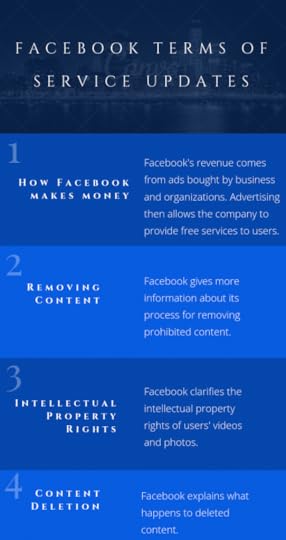 Facebook makes four updates to its Terms of Service.
Facebook makes four updates to its Terms of Service.The update does not change Facebook’s policies or how the platform works in any way. It merely explains existing information more clearly.
The specific information that Facebook is updating includes the following:
How Facebook makes money: Facebook better explains that it makes money through ads paid for by businesses and organizations to provide users with the platform’s free services. Removing content: Facebook gives more information about its process for removing content that does not adhere to its terms or policies.Users’ intellectual property rights: Facebook clarifies that users own the intellectual property rights of their own photo and video content, even after they share it. By sharing their content on the platform, users give Facebook permission to display that content. When users delete the content, that permission ends. What happens after content deletion: Facebook will better explain what happens after a user deletes content. According to Facebook, the content is no longer visible once deleted, but it may take up to 90 days to be entirely removed from the platform’s systems.
The updated Terms of Service will take effect globally on July 31, 2019. Facebook says users can preview the changes on its Terms of Service page.
Facebook’s efforts does not end with the full global rollout of the updates. According to Benckert, the company will still continue to make the plaform more transparent to users.
“Beyond these updates, we’ll keep working on ways to make sure people understand how our business works, how their information is used, and how they can control it,” said Benckert.
Facebook and Transparency
The updated Terms of Service is one of Facebook’s many transparency efforts. Earlier this year, the network introduced a new “Why am I seeing this post?” feature, giving users more control over the content they see in their News Feeds, helping them better understand the algorithm. Additionally, the platform now has a “Why am I seeing this ad?” feature that functions similarly, giving users information about how businesses and organizations target them.
 Facebook’s “Why am I seeing this?” feature provides more ad targeting transparency.
Facebook’s “Why am I seeing this?” feature provides more ad targeting transparency.As elections are nearing in the US, transparency becomes even more important. In June, the social media company rolled out transparency tools for advertisers who are purchasing social issues, elections, or political ads. The tools help prevent foreign interference in elections, such as the one lead by Russia during the 2016 US presidential election.
Following the Cambridge Analytica scandal, in which the data firm harvested data from more than 80 million users’ profiles, transparency has also been a major priority for Facebook. Users began researching how to download their data and how to delete their account out of fear for their personal information and sudden distrust of the platform. Facebook has since been working to redeem itself, rolling out new transparency features and giving users more control over their accounts, privacy settings, and personal information. Although the platform’s efforts have been diligent and admirable, Facebook recognizes that the pursuit of transparency is an ongoing project.
 Mark Zuckerberg testifies before congress for the Cambridge Analytica data hack.
Mark Zuckerberg testifies before congress for the Cambridge Analytica data hack.With so many users finding it difficult to fully understand how Facebook works, the update to the Terms of Service will likely be a welcome change. Knowledge is power; the more users know about the platform they use, the more in control they will feel. Perhaps the changes will encourage users who previously deleted their Facebook accounts to return. Or perhaps users who did not create a Facebook account will consider joining, now that the platform will be easier to understand.
Written by Anna Hubbel, contributing writer
The post Facebook Updates Terms of Service for Better Clarity and Transparency appeared first on AdvertiseMint.
July 5, 2019
New to Instagram: Ads in Explore
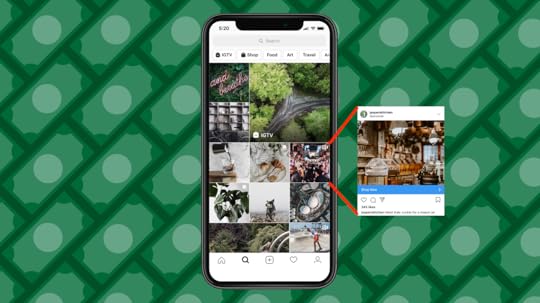
JUL. 5, 2019
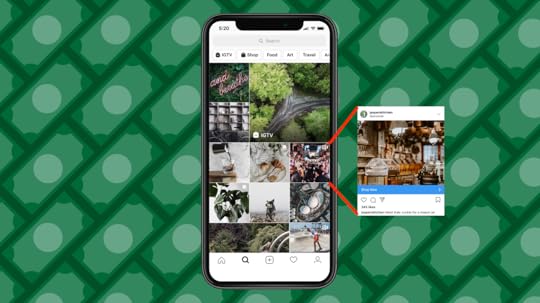 Image Courtesy of Tech Crunch
Image Courtesy of Tech CrunchInstagram’s Explore tab just became a more attractive platform for advertisers. Parent company Facebook recently decided to begin inserting ads into the content discovery space.
According to Tech Crunch, to avoid suddenly overwhelming users with advertising content in the Explore grid, ads will only appear after users tap a post and scroll through it to browse similar content. It’s a subtle, non-intrusive way to give users sponsored content to discover without pushing too many ads that clog up the Explore grid. For now, the Explore grid will be ad-free, with ads only appearing after tapping a post and scrolling.
Eighty percent of users already follow a business on Instagram, according to the social network. Businesses and brands are highly active on the platform, connecting with users and giving them unique content. Additionally, more than 50 percent of Instagram’s users already utilize the Explore tab on a monthly basis.
“Whether it’s shopping, catching up on stories, or discovering the latest trends, we see people actively looking to connect with brands they like,” Instagram said in a blog post. “That’s why, over the next few months, we’ll be introducing ads in Explore feed.”
Before expanding the Explore ad placements to other brands over the next few weeks, Tech Crunch says Instagram will first test the placement option with its own ads promoting IGTV. The format will roll out more broadly over the coming months, reports Tech Crunch.
“For advertisers, this is an opportunity to be part of what’s culturally relevant and trending while reaching new audiences who are looking to discover something new,” said Instagram. “Advertisers can easily extend their campaigns using automatic placements with a simple opt-in to reach audiences in Explore.”
How to Buy Explore Ad Slots
According to Tech Crunch, advertisers who want in on the new Explore ad format can buy through Facebook Ads Manager and API. It will work similarly to how one would purchase ad placements for the Instagram feed and Stories.
As Instagram slowly begins introducing the Explore format to advertisers, advertisers will at first need to opt in. However, Explore placements will eventually become the default.
How Instagram Explore Ads Work
When a user navigates to the Explore tab, the grid will look the same as always: full of personalized content based on the individual user’s interests and engagement. When the user taps a photo or video from the grid, it will open as usual to full screen. If the user scrolls to view similar content, photo and video ads will appear dispersed throughout the feed, in between regular, unsponsored content.
While the insertion of Explore ads will start out slowly, it will likely increase in volume as Instagram gets a feel for the new placement’s popularity.
Instagram, Explore, and Advertising

Explore has been a consistent space for content discovery since it first rolled out in 2012. It gives Instagram users a space to find content that matches their interests and connect with content creators in a searchable platform. Until now, Explore has been an ad-free space, giving users content that Instagram’s algorithm determines to be valuable and personalized to each individual user.
Instagram has been an increasingly valuable space for advertisers. The platform has added a number of advertising options since it’s launch, including feed ads, Shoppable Photo Tags, Stories ads, and Checkout with Instagram. Adding Explore ad placements seems like the next logical step for the platform.
Instagram has provided Facebook with a steadfast stream of ad revenue. As Facebook struggles to monetize News Feed and Facebook Stories, capitalizing on Instagram’s popularity with both brands and users is a logical step for the company. The key is not to go overboard by flooding Instagram with ad content; otherwise, Instagram risks overwhelming its users.
“As we continue to invest in Explore, we want it to be the best place for people to discover something new and for businesses to connect with people who might become meaningful customers,” said Instagram.
Instagram says users will continue to have control over the ads they see. They can visit the Instagram Help Center to learn how to adjust their ad preferences.
Written by Anna Hubbel, contributing writer
The post New to Instagram: Ads in Explore appeared first on AdvertiseMint.
July 3, 2019
What’s New: Instagram Down. Plus, “Join Chat” Sticker Rolls Out
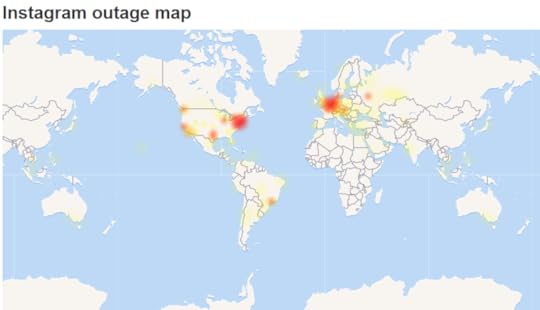
July 3, 2019
It has been a while since Instagram has made it in the headlines, whether for a feature rollout or some other important announcement, such as reaching a new milestone of one billion active users.
However, Instagram kicks of July with an eventful week, and frequent users of the app have undoubtedly noticed that 1) Instagram is down and 2) It has an exciting new Stories feature.
Instagram Is Down
Four months after the last blackout, Facebook-owned Instagram is once again down, giving users login and sharing problems. Many Instagram users find that they are unable to view most images and videos on the app, which are failing to load.
The issue doesn’t only occur on the app, however. Instagram is also malfunctioning on desktop, where images and videos fail to appear on screen. Instead, an error message, “Couldn’t load image. Tap to retry.” appears. Instagram Stories is facing a similar problem, with posts only displaying a “loading” icon.
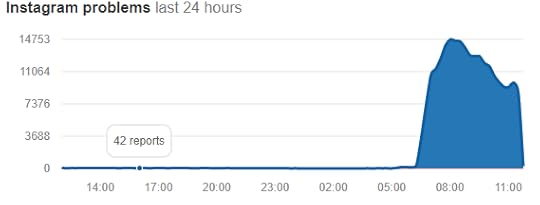 Reports of problems spike at 8 a.m. Photo courtesy of DownDetector.com
Reports of problems spike at 8 a.m. Photo courtesy of DownDetector.comThe problems, according to DownDetector.com, a website that monitors service interruptions and outages, began at 5:45 a.m., PST. The issues are affecting both U.S. and Western Europe users.
 The service interruption affects users in the United State and Western Europe.
The service interruption affects users in the United State and Western Europe. Reports of the Instagram service interruption began at approximately 5 a.m. then spiked at 8 a.m., with 14,753 complaints. Ninety-one percent of users reported issues with the feed, five percent reported issues with the website, and two percent reported issues with logins.
Instagram takes to Twitter, addressing the app’s issues.
 Instagram addresses the issue on Twitter.
Instagram addresses the issue on Twitter. “We’re aware that some people are having trouble uploading or sending images and videos on Instagram,” says the photo-sharing company. “We’re sorry for the trouble and are working to get things back to normal as quickly as possible.”
Currently, there is no word on when Instagram will return to normal. If there’s anything to learn from the last outage, it’s possible that the photo-sharing app won’t be restored to its normal functions until tomorrow.
Instagram Introduces “Join Chat” Sticker
Recently, Instagram debuted a new sticker that brings more interaction to Direct.
The sticker, called “Join Chat,” allows followers to participate in a group conversation with the poster of the Story, as well as that poster’s followers. Once clicked, the sticker will redirect to a group chat. The original poster can decide whether or not to accept people’s requests to join the cat.
To use the “Join Chat” sticker, users need to only follow a few steps:
Step 1: Create a Story and open sticker tray.
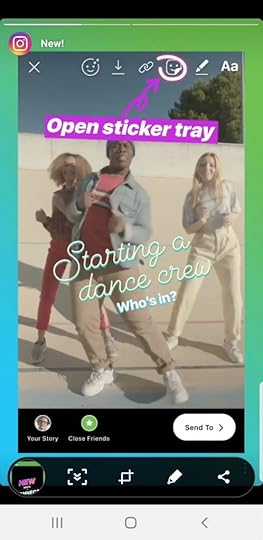
Step 2: Click the “Chat” sticker.
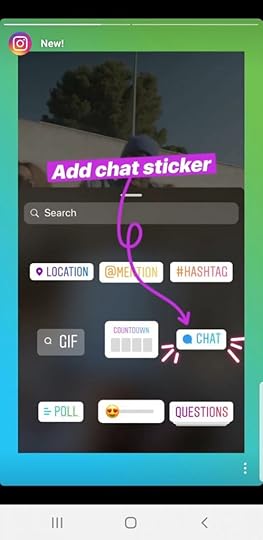
Step 3: Position the sticker on the Story and share to friends.
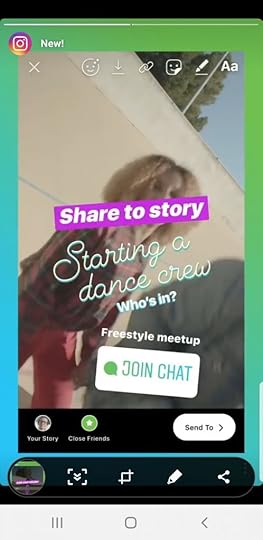
This new feature will certainly increase time spent on the platform, as users will likely spend more time conversing with others in Direct. It will also likely keep users returning to the app as they receive DM notifications from the group chat.
As a platform that receives its revenue from advertising, it won’t be surprising that Instagram will monetize Direct in the years to come. After all, with more time spent on Direct comes more potential eyes to see Instagram ads. Messenger’s monetization (currently, Messenger supports ads) speaks to this possibility. It won’t be surprising that Direct will follow suit.
By Anne Felicitas, Editor
The post What’s New: Instagram Down. Plus, “Join Chat” Sticker Rolls Out appeared first on AdvertiseMint.
June 28, 2019
How to Create Facebook GIF Ads

Jun. 28, 2019
 Tim Van Der Kuip / Unsplash
Tim Van Der Kuip / UnsplashIn the age of instant messaging, communication has become visually centered. The messages millennials and the younger generation send to their peers are often punctuated by emojis. Sometimes, no text is included at all. Instead, only a single looping animation appears, evoking meaning and emotion. Those ubiquitous looping graphics are called GIFs.
A GIF, or Graphical Interchange Format, is a series of images or one soundless video that continuously loop without pressing play. Although GIFs exploded into pop culture during the past several years, they have existed since 1987, invented by a man named Steve Wilhite, a computer scientist at CompuServe who wanted to create animated images in the smallest file size.
GIFs slowly phased out of popularity when, in 1995, the Unisys Corp. demanded royalty payment for software that used its patented algorithm. This algorithm, called Lempel-Ziv-Welch, or LZW for short, creates the GIF. In protest, developers stopped using GIFS and instead created alternatives, such as the PNG. Now GIFs have crept back into relevance, protected by copyright laws under fair use.
Although currently omnipresent in social media and instant messaging apps, GIFs are not yet fully embraced in one area of the digital world: Facebook advertising. Spending some time on News Feed reveals a deficit in GIF ads while video, carousel, and image formats abound. Does the GIF’s scant presence on Facebook allude it its efficacy? Hardly. In fact, two studies show the GIF to be a beneficial part of a marketer’s advertising strategy.
The Benefits of Using GIF Ads
Preparing to launch the Dell XPS 12 Convertible Ultrabook, a laptop that folds into a tablet, Dell’s marketing team struggled to showcase the device’s functionality in its email campaign. A large video file would crowd customers’ emails and a static image couldn’t accurately demonstrate the product’s cutting-edge capability. The team decided that animation, specifically a GIF, was the answer.
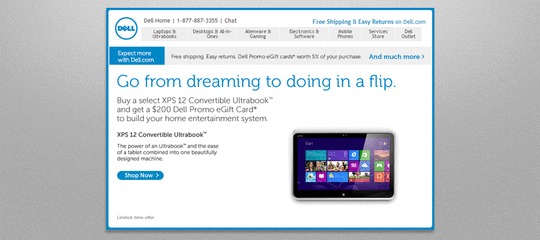 Dell’s email contains a GIF that demonstrates the transformation of the Dell XPS Convertible Ultrabook.
Dell’s email contains a GIF that demonstrates the transformation of the Dell XPS Convertible Ultrabook.The email with the GIF resulted in a 6 percent increase in open rate, a 42 percent increase in click rate, a 103 percent increase in conversion rate, and a 109 percent increase in revenue. By looping without the need to press play, the GIF provided convenience while forcing both interested and uninterested customers to watch. (Customers couldn’t pause the animation, as is the nature of GIFs.) The looping format also accurately showed how the laptop flipped and folded into a tablet. Dell’s email campaign proved the GIF to be an effective way to demo complicated products without the need to craft a long video.
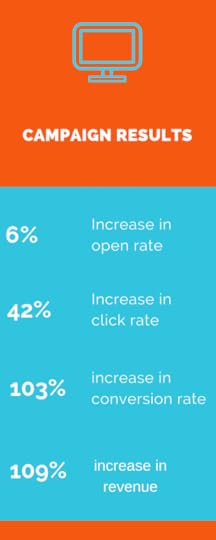
GIFs aren’t only useful in product demos. They are also useful in connecting with a younger audience.
A Harris Poll survey commissioned by GIF platform, Tenor, found that GIFs communicate thoughts and emotions better than the English language. Of the 2,000 interviewed US participants, the majority of respondents across age groups claimed to feel more connected to the people they frequently message when using emojis and GIFs. Sixty-eight percent of the millennial respondents claimed to be more comfortable expressing emotions through GIFs than through phone conversations.
GIFs, unlike words, can convey both meaning and emotion. For example, a GIF that shows a happy person jumping and clapping conveys excitement better than the words “I’m so excited,” which could be read with either a jubilant, apathetic, or sarcastic tone. GIFs can also help the messenger appear more in tune with pop culture, as many GIFs contain memes that reference trending events.
GIFs can be a great addition to a marketer’s digital advertising campaign, and thanks to the existence of GIF-creation sites, anyone can make a GIF, even those who have no Photoshop experience.
How to Create a GIF on Giphy
Giphy is a free website that allows you to create GIFs for public use. Anyone can create a GIF using images, video, or URL. The process for creating a GIF using a URL or video is the same. The example below shows the process for a URL conversion.
Step 1: Enter video URL.
Giphy supports URLs from its site, as well as YouTube and Vimeo.
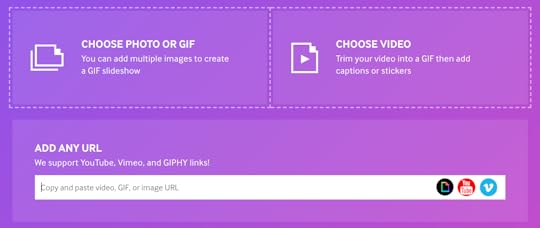
Step 2: Trim video
To capture the main message of your video, you must trim it. The example video below runs for 39 seconds, with unnecessary parts that need to be excluded. The trim only includes the heart of the message, the sweet line from Avengers Endgame, “I love you 3,000.” I adjusted the start time to begin when the words “I love you 3,000” first appear on screen. Then I trimmed the video’s duration at .8 seconds to exclude the rest of the scene from the GIF.
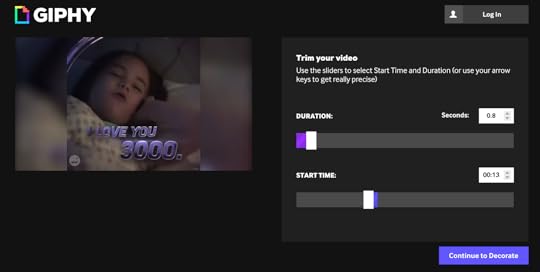
Step 3: Decorate your GIF
You can decorate your GIF with captions, filters, stickers, and drawings. Conveniently, the video already has a caption. However, for the sake of this tutorial, I wrote the words “Me to my cats” in big white font, providing context for the message “I love you 3,000.” The text you add must communicate the message you want to convey and compliment the animation you choose. You can drag your text anywhere on the GIF.
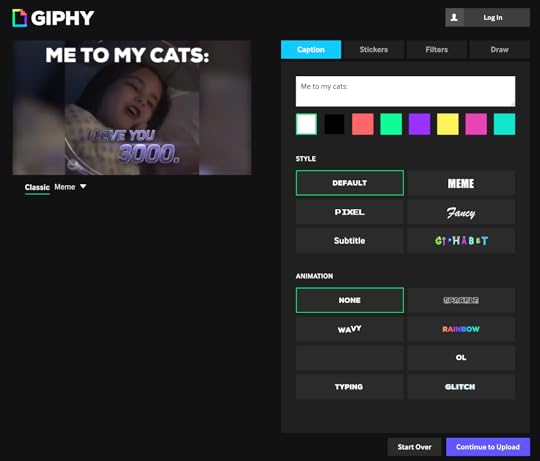
Step 4: Upload the GIF to Giphy
The GIF will upload to the site’s database for public use. You must enter relevant tags to help users find your GIF in the site.
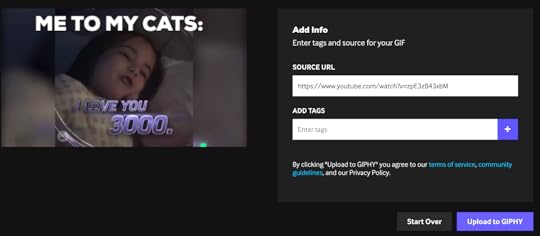
Step 5: Use your GIF
You can share your GIF to social media, grab the media link, or embed it to your site or blog post.
The process of creating a GIF using images is similar to the process of creating a GIF using a video or URL. You simply upload your images and adjust the duration to control how quickly you want the images to cycle through. Once converted as a GIF, the images will appear in a quick slideshow-esque fashion.
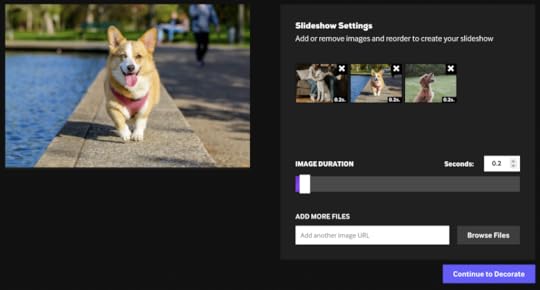
How to Create Facebook GIF Ads
For many years Facebook did not support GIFs; in fact, Facebook didn’t allow them into the platform until 2015. Since then, Facebook has welcomed them. In 2017, Facebook rolled out GIFs in comment sections and Ads Manager, giving advertisers the opportunity to run GIF ads. Facebook’s embrace of GIFs was likely precipitated by its popularity among Facebook users. In 2017, people sent nearly 13 billion GIFs through Messenger—that’s almost 25,000 GIFs sent each minute.
There are two ways to create Facebook GIF ads. One is to boost a post and the other is to create the ad in Ads Manager.
Creating GIF Ads by Boosting a Post
Step 1: Upload the GIF to your page post.
Although you can enter a GIF link that populates the animation into your Facebook post, GIF links don’t work in page posts due to third party limitations. Instead, you must download the GIF to your computer and upload it to your page post.
A note about Giphy downloads: You can’t download GIFs from your desktop, but you can do so from the Giphy app. The best—albeit roundabout—way of downloading Giphy GIFs is to save them to your phone. You can then email them to yourself, download them to your computer, and upload them to your post.
Step 2: Boost the post
When you boost your post, make sure to fill in all required information: choose your objective, create your target audience, set your budget, and select your call-to-action button.
Creating GIF Ads in Ads Manager
When choosing the GIF for your ad, Facebook recommends you do the following:
Choose high quality images or animations.Choose subtle motion.Use a link ending with .gif.Use a GIF with a file size less than 8MB.Use a GIF with less than 20 percent text on the image.Avoid GIFs that flash or appear grainy.Avoid splashy, one-off posts. Use GIFs to tell a bigger story.
You must also abide by Facebook’s video recommendations and specifications:
Recommended Length: Up to 15 secondsRecommended Aspect Ratio: Vertical (4:5)Sound: Enabled with captions includedRecommended format: .mp4, .mov or .gifRequired Lengths By Placement:Facebook: 240 minutes maxAudience Network: 5 – 120 secondsInstagram Stories: Up to 120 secondsInstagram Feed: Up to 120 secondsRewarded Video: 3 – 60 secondsResolution: 600px minimum widthFile size: Up to 4 GB max
Step 1: Choose an objective the supports the video format.
Objectives eligible for the video format are video views, brand awareness, reach, traffic, app installs, lead generation, messages, conversion, engagement, and store traffic.
Step 2: In the ad set under the “Format” section, upload your GIF by clicking “Upload Video”
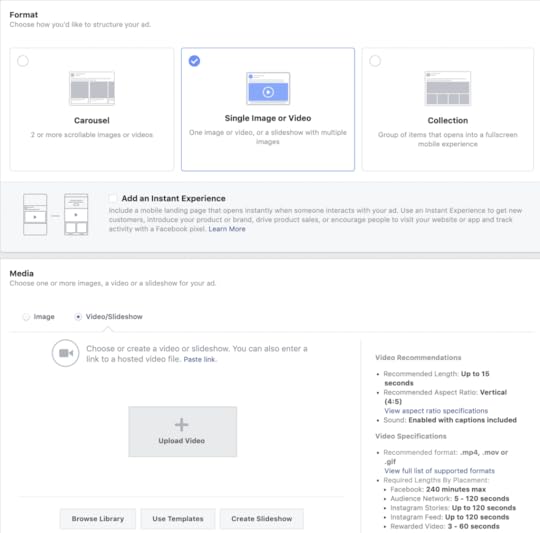
Step 3 : Submit to Facebook for review
After you’ve finished all the necessary steps to create a Facebook ad—creating your audience, writing your copy, linking to your landing page, choosing a CTA button, setting up your Facebook pixel—submit the ad for review. If you want to see what your ad looks like on your phone, send a preview.
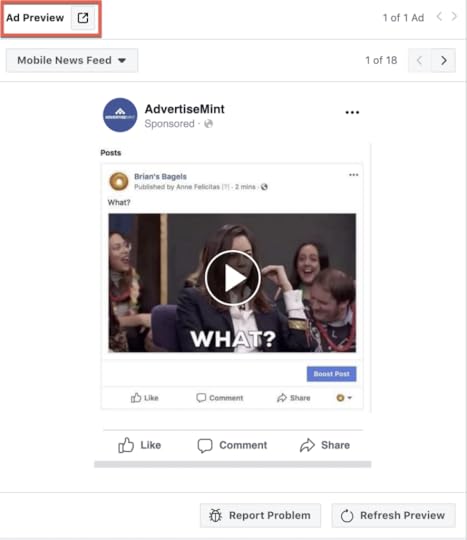
GIFs hold a special place in pop culture. It is ubiquitous in social media and people’s instant messages. Yet, GIFs have not been fully embraced by the digital advertising community, even though it has proven to be a hit among the younger generation and a useful asset in email marketing. Nonetheless, as communication becomes more and more visually-centric, it’s hard to believe that GIFs are going to be phased out anytime soon.
By Anne Felicitas, editor
The post How to Create Facebook GIF Ads appeared first on AdvertiseMint.
June 19, 2019
How to Block Comments on Instagram and Facebook
By Anne Felicitas | Jun. 19, 2019

For many, stalking comment sections can be both entertaining and vexing. On the one hand, it’s amusing to watch people bicker in long paragraphs and spectators drop in their snide commentaries. On the other hand, it’s frustrating to watch people argue over remarks and topics that are inconsequential. These days, anyone can feel enraged and offended over nothing.
Yes, the comments section is both a curse and a blessing. Invented as a tool to foster meaningful discussions, it is now a battleground for keyboard warriors and ruthless trolls emboldened by anonymity. Posting on the internet is to risk exposing oneself to ridicule and hate.
A few social media networks allow you to block unwanted comments. Instagram and Facebook, specifically, allow you to block comments from the accounts you choose and filter out comments with offensive words. There are several reasons that may compel you to block comments on social media.
A Case for Blocking Comments
Higher Click-Through Rates
In an A/B test by Agora Pulse, the researchers found that Facebook ads with negative comments received lower click-through rates (CTR) than ads with positive comments.
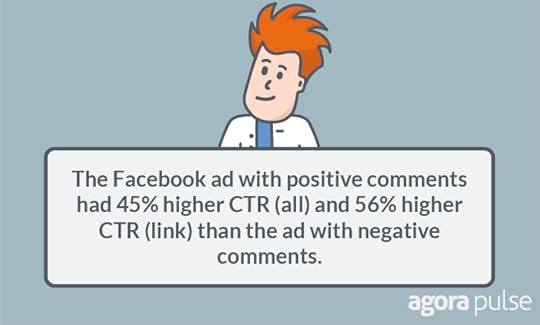 Photo courtesy of Agora Pulse
Photo courtesy of Agora Pulse The researchers tested ads identical in copy, objective, ad format, and call-to-action buttons. However, one ad contained only positive comments while the other only contained negative comments. The results showed that the ad with positive comments received a 1.88 percent CTR while the ad with the negative comments received a 1.30 percent CTR.
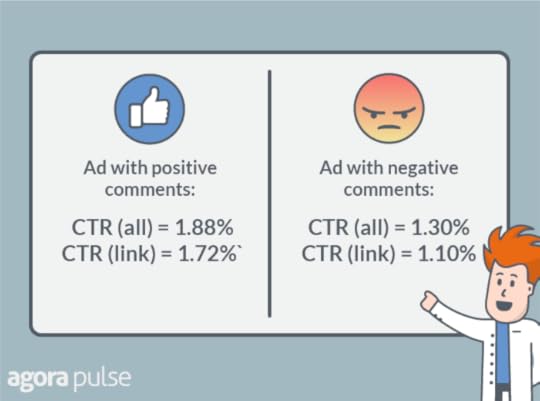
Photo courtesy of Agora Pulse
The ad with the positive comments likely performed better because comments function as social proof. Users are less likely to click on an ad that people are bombarding with negative reviews. If people claim that the business or product advertised is bad, then it must be.
Piece of Mind
In an April 2018 survey by Pew Research Center, teens were asked why social media is harmful to their age group. The common answer? Bullying.
Of the teens surveyed, 27 percent said bullying, as well as rumor spreading, made social media harmful to their mental health.
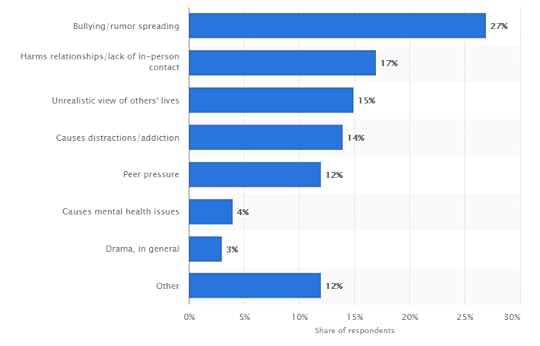
Photo courtesy of Statista
This revelation isn’t at all surprising. Mental health professionals have long suspected social media to be detrimental to the well-being of its users. According to CNN News, a recent study by the American Psychological Association found an increase in reported negative psychological symptoms from an age group called the iGen, teens born in 1995 or later. Researchers suspect that the rise of social media resulted in the negative psychological symptoms in teens.
Of course, correlation does not mean causation. One mental health professional advises the public to be cautious when correlating mental health with social media use.
“We can’t say for certain that the rise we’re seeing is the direct result of social media use,” said Aaron Fobian, clinical psychologist and assistant professor in psychiatry at the University of Alabama, to CNN News. “For example, teens could have depressive or anxious symptoms and therefore spend more time on social media outlets to look for a way to connect.”
Still, if the ping! of your comment notifications fills you with dread, blocking comments or filtering out offensive ones may give you piece of mind.
Curbing Defamation
Blocking comments may be especially important if you manage an online business page. As a business owner, you must upholf the reputation of your brand to attract and keep customers. However, there are bad actors—perhaps a competitor, scammer, or disgruntled ex-employee who’s determined to take you down—who may make false, damaging accusations or statements about your business on your posts and ads.
In fact back in 2018, bitcoin scams were proliferating in the comment sections of posts published by several companies. One such company was the online publishing website The Verge whose comment sections were attacked by imposters using a fake account donning the publisher’s name and logo. The scam invited victims into providing personal information in exchange for free bitcoins.
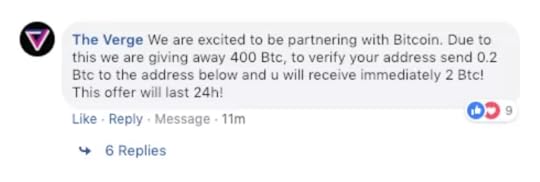
Photo courtesy of the Verge
The scam, which can be damaging to The Verge’s brand, fits the definition of online defamation as described by HG.org, a law and government online resource:
“When individuals feel that their reputation is damaged because of a reckless comment made on Facebook, Twitter or other social media channels, they may consider pursuing a defamation lawsuit against the insulting party.”
There are many ways to handle a person who defames your business, such as taking legal action as suggested by HG.org. However, taking legal action can be expensive and time-consuming. An alternative is to shut down perpetrators by blocking their comments from appearing on your posts, which Instagram allows you to do.
A Safe Place to Share Ideas
In the world of social media, engagement is key to increasing the reach of your organic posts. Both the algorithms of Instagram and Facebook place posts that are teeming with comments, likes, and shares higher in users’ feeds. Because social media engagement is so pivotal to organic reach, you, too, should strive to increase engagement on your posts, and you can do that by garnering comments. However, trolls may cow followers into silence.
By eliminating trolls from your pages, you are providing followers a safe space to voice their ideas, consequently encouraging them to write comments on your posts. Rather than spewing insults at each other, followers are forced to convey their opinions in a productive and useful way that avoids unnecessary conflict.
A Clean and Professional Page
As a business owner, you’re responsible for maintaining your brand’s image. There are many ways to do this, and one involves aligning yourself with reputable partners, such as influencers or celebrities who aren’t plagued by scandals.
Aligning yourself with the wrong kind of followers can also damage your brand’s reputation. Walmart, for example, has been negatively associated with the disreputable customers that shop at the company’s stores, so much so that those customers have become a meme, earning the title “People of Walmart.” Of course, not all of Walmart’s customers are similar to the ones portrayed in memes, yet people associate both the brand and its customers with ill repute.
Trolls who often post offensive comments on your page and attack other followers may negatively affect your brand’s image. People may conclude that if your brand attracts unsavory individuals, your brand must also be unsavory.
An Alternative to Deleting Comments
Some businesses delete offensive remarks from trolls in an attempt to keep their comment sections clean. However, this practice is a double-edged sword. On the one hand, you’re keeping your comments section from negativity, and as the aforementioned Agora Pulse A/B test showed, this can improve the performance of your posts. On the other hand, deleting comments shows that your business is not transparent, and it can provoke further criticism from trolls, who likely will have no qualms over calling you out.
How to Block Comments on Instagram
When you block comments from your Instagram account, you are only blocking the comments that appear on your posts. You can change your commenting preferences from the Settings page of your Instagram app. These steps are applicable to your personal account and your Instagram business account.
Step 1: Go to your Instagram settings
To get to your settings, first navigate to your profile. From there, click the three-lined hamburger icon from the upper-right corner of the screen. Then click “Settings” from the bottom of the page.
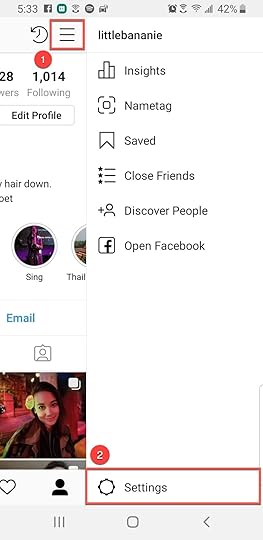
Step 2: Go to “Privacy”
The “Privacy” tab is the third option in the settings menu, located between the “Business” tab and the “Security” tab. Click “Privacy” to access your comments settings.
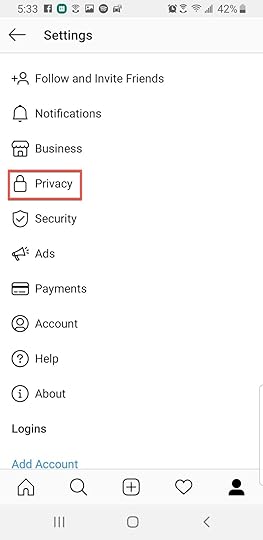
Step 3: Click “Comments”
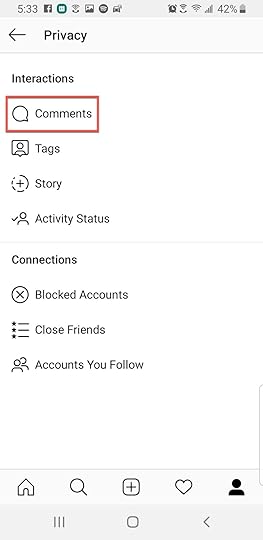
Once you arrive to your comments settings, you will find several different options to manage the comments on your posts. Each option will handle unwanted comments differently, so you must choose the option that works best for you.
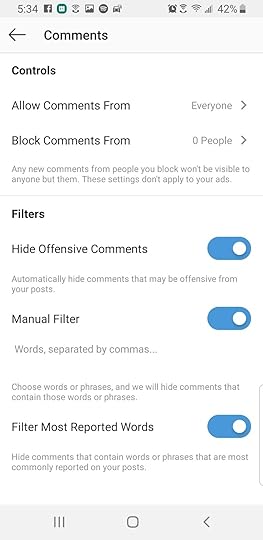
From the top of the list, under “Controls,” you will see an option called “Allow Comments From.” This option allows you to enable comments from specific groups. You can allow comments from everyone, including the people who follow you, the people you follow, and the people who aren’t connected to your account (you don’t follow them, and they don’t follow you).
If that option is too broad for your liking—for example, you don’t want to receive comments from random Instagrammers who find your posts on Discover—you can, instead, only allow comments from the people you follow and the people who follow you. If you want even stricter limitations, you can choose to allow comments only from your followers.
You can also block comments from specific users. You can use this option in tandem with the “allow comments” option. For example, you can choose to allow comments for everyone except for your annoying roommate, Carla. You can choose to allow comments from only your followers except your nosy coworker, Greg.
Of course, disabling all comments may seem drastic to you. If you only want to filter offensive comments, you can do so using Instagram’s filter tool. You can use this filter tool in tandem with your comments settings; meaning, you can set your comments preferences while having comment filters in place.
To turn on comment filters, swipe the toggle button called “Hide Offensive Comments” to the right until the button turns from gray to blue. Once enabled, Instagram will hide comments it deems offensive. Because the meaning of “offensive” is arbitrary and defined only by Instagram, the comments Instagram hides may, at times, seem inoffensive to you and to the person whose comment was blocked.

If you want to block comments containing specific offensive words, you can instead turn on manual filter. For this option, you will need to type in the words you don’t want to see in your comment sections. When the filter identifies a comment as offensive, it blocks the comment from everyone’s view. Only the original writer of the comment can still see it; that way, the violating user is less likely to make the offensive content viewable by, for example, reposting variations of the comment to bypasses the filtering tool.
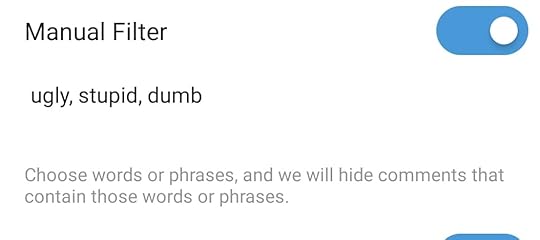
Another option is to filter comments containing the most reported words on your posts. For example, if your followers often report comments on your posts with the words “stupid,” “ugly,” or “dumb,” Instagram will filter out comments containing those words.
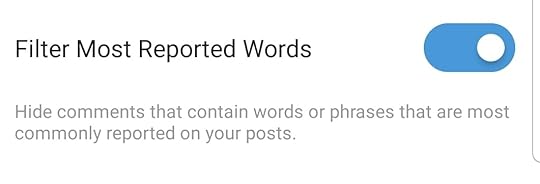
If you spot an offensive comment that Instagram’s filtering tools somehow missed, you can long-press the comment and click the exclamation icon that appears on the upper-right corner of the screen.
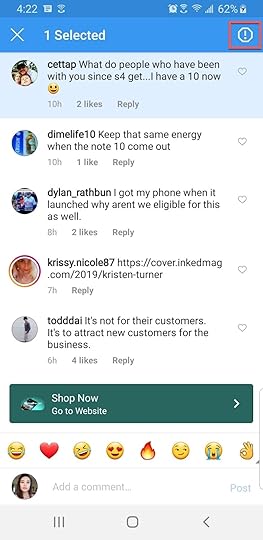
How to Block Comments on Facebook
Although you can block comments from the posts on both your personal account and business page, the options for your personal account are not the same as the options for your business account.
Personal Account
Step 1: Click the inverted triangle icon on the upper-right corner of the screen then click “Settings” at the bottom of the menu.
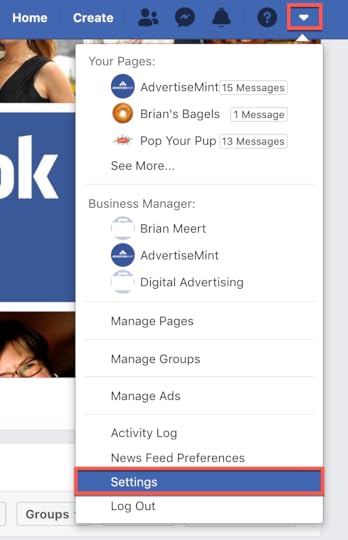
Step 2: From the left column, click “Public Posts” then click the “Public Post Comments” section.
From this section you can choose who can comment on your public posts. You can either choose the public (everyone, including people who are not in your friends list), friends of friends, or only friends.
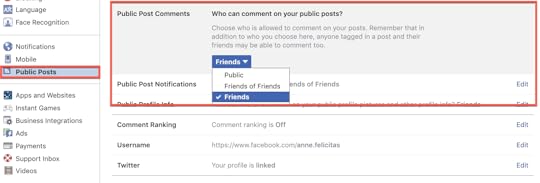
Facebook Page
The comment-filtering options from your Facebook page is different. In fact, it is a much better tool than the one provided for your personal account, allowing you to create more granular restrictions. Specifically, you can choose to block comments with specific words and filter comments containing profanity.
When you block certain words, these words will be immediately marked as spam by Facebook as soon as they appear on your page. Here’s how you block words on your Facebook page.
Step 1: Go to settings
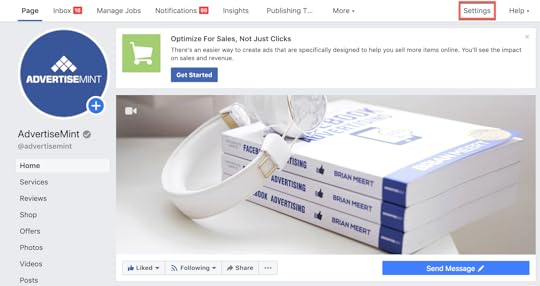
Step 2: Go to “General” then “Page Moderation”
From the “General“ section, scroll down to “Page Moderation.” Click “Edit.”
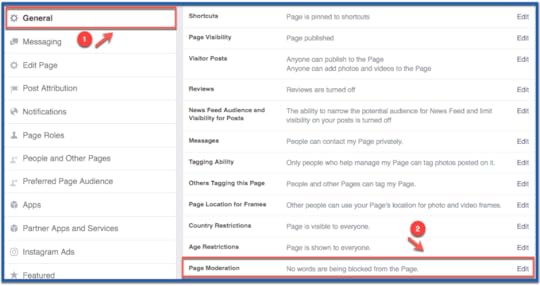
Step 3: Enter words to block
Type in the words you want to block then click “Save Changes.”
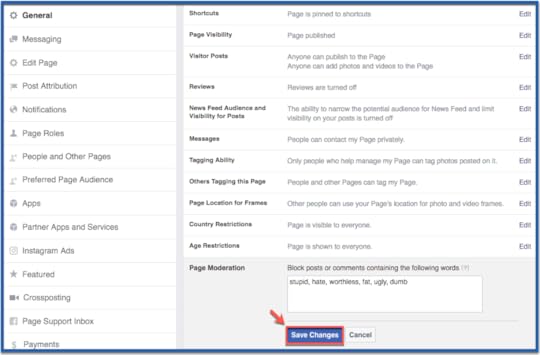
Step 4: You’re Done
Facebook will block the words as soon as they appear on your page.
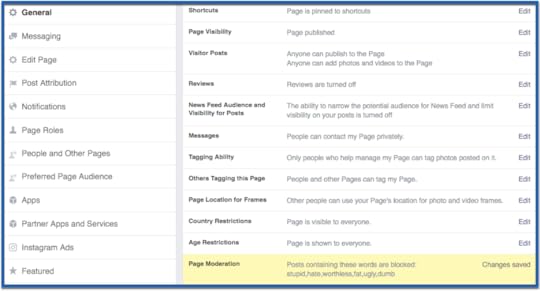
Filtering profanity works differently than blocking words. While you choose the words you want to block, Facebook determines which profanity to block based on commonly reported words and phrases marked as offensive by Facebook users. Facebook also determines which profanity to block according to the degree you choose. Choosing medium will block moderately vulgar profanity while choosing strong will block only strongly vulgar profanity.
Step 1: Choose degree then save
From “General,” scroll down and click “Profanity Filter.” Choose your degree then click “Save Changes.”
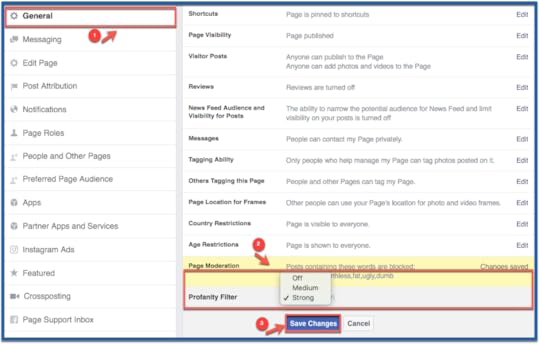
Step 2: You’re done
Your changes were saved. Profanities that fall under the degree you choose will be blocked from appearing on your page.

If Facebook missed comments that contained profanity or offensive words, you can manually hide the comment or report it to Facebook by clicking the three-dotted button that appears alongside the comment.
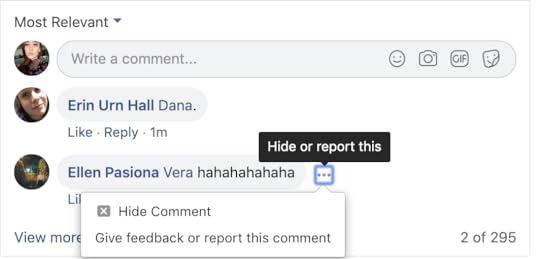
The Disadvantage of Blocking Comments
Although there are many legitimate reasons to block or filter comments, one disadvantage arises: loss of engagement.
Arguments often result in rapid engagement, as commenters heatedly respond to one another. These arguments spawn into a long string of back-and-forths, which the algorithm values. The more engagement your post receives, the higher it will appear in users’ News Feeds. The higher it stays in News Feed, the more exposure it receives.
Whether or not you should block comments is up to you. It depends on what you value most. If you’re in desperate need of engagement, then perhaps blocking and filtering comments may not be the most prudest choice. However, if you organically garner hundreds of comments, then missing out on a few likely won’t harm the performance of your posts.
The post How to Block Comments on Instagram and Facebook appeared first on AdvertiseMint.
June 10, 2019
How to Increase Organic Reach on Facebook

Anna Hubbel | Jun. 10, 2018
 Rawpixel / Pexels
Rawpixel / PexelsWhen marketers say “organic,” they’re not referring to those expensive products in the produce section. Instead, they’re referring to organic reach on Facebook. Organic posts are content you share on your page or Timeline for free. Status updates, videos, live streams, and photos are a few examples of organic posts.
Other than the call-to-action button that appears on the ad, one feature that differentiates a sponsored post (Facebook ad) from an organic post is the presence of a “Sponsored” or “Paid Sponsorship” label. Facebook ads are labeled as sponsored while organic posts are not.
 The organic post (left) doesn’t contain a “paid” or “sponsored” label while the ad (right) does.
The organic post (left) doesn’t contain a “paid” or “sponsored” label while the ad (right) does.Organic posts also don’t appear to a chosen target audience. You share posts to your Timeline, hoping your followers see them. This makes organic reach so difficult to increase: you don’t have access to all the audience targeting tools available with Facebook ads. You simply craft a good post, publish at the time of day your audience is most active, and keep your fingers crossed. As if reaching users with organic posts isn’t hard enough, Facebook organic reach has been declining as of late, making it even more of a challenge. There are two main reasons for this.
First, Facebook has become a highly competitive platform for both ads and organic content. As of April 2019, Facebook has 2.38 monthly active users. Back in November 2017, Facebook announced that the platform had more than six million advertisers. That’s a lot of people producing content on the platform. The result: a clogged up News Feeds full of content that pushes your organic posts to the bottom of the feed. Organic posts that are seen by their intended audiences are typically there-and-gone in a flash.
Second, Facebook updated the algorithm in 2018 to prioritize posts by friends and families over posts by brands, publishers, and advertisers. Reaching friends and family organically is already difficult for regular Facebook users, but it is even more of a challenge for those with business accounts. With the update to the algorithm, Facebook users—both business account holders and regular accounts holders—must pay to play.
How Facebook Advertising Increases Your Reach
With both the high demand for News Feed space and the new version of the algorithm, organic reach is very difficult to achieve for businesses. If you invest in Facebook ads, it’s still a challenge; however, the various tools and features Facebook has available for its advertisers makes it easier to reach your audience.
For example, Facebook offers a number of ad targeting options that help you reach the right audience. You can target users based on location, age demographics, device, interests, and behaviors. These targeting options allow you to serve your ads to users most likely to be interested in your business. Facebook advertising also gives you ad objectives to choose from. If, for instance, you want to run a campaign promoting your app to get more downloads, you could choose the app installs objective. With this objective, your ad will appear to users most likely to download your app.
Additionally, Facebook advertising offers a variety of different ad formats and bidding options, allowing you to be creative with your content at a cost you can afford. Your ad format options include video, single image, carousel, and Instant Experience.
Although Facebook advertising certainly helps you achieve your business goals, you shouldn’t give up on organic reach. There’s still value in posting organic content, and it’s still possible to increase your exposure on the platform. You just have to work a little harder.
Tips for Improving Your Facebook Organic Reach
To improve your organic reach on Facebook, you must first understand how the algorithm works. To determine which post appears on top of users’ feeds, the algorithm gives each post a score, and this score is determined by three factors: the person who published the post, the type of post, and the post’s engagement numbers. A highly ranked Facebook post is published by an account with which users often interact, and it is the type of format (for example, image versus video) users most often engage with. Engagement numbers also boosts a post’s rank.
With Facebook’s algorithm in mind, there are a number of different ways to increase your reach without paying for Facebook ads.
Use a Variety of Post Formats
To increase your engagement, try increasing your post variety. Contrary to what you might think, your posts aren’t limited to text, images, and videos. In fact, there are several formats you can use. When writing a post, look at Facebook’s list of post types. You can view the full list by clicking the three-dotted menu icon.
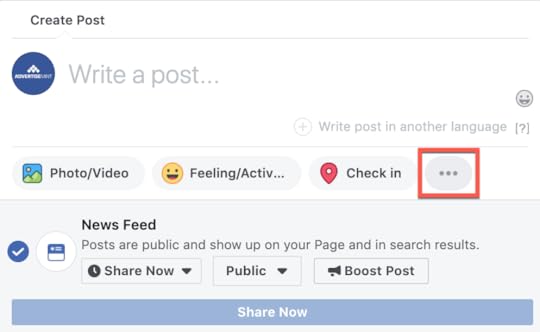 More Facebook post options can be accessed by clicking the three-dotted menu.
More Facebook post options can be accessed by clicking the three-dotted menu. In addition to adding images and videos to your posts, you can also tag products, support a nonprofit, create a poll, check in at a location, add a feeling or activity, add a “Send Message” call-to-action button, and even invite users to join a Watch Party on your page. Experiment with these different post types to engage with your audience in creative ways and to increase post diversity, keeping your content from becoming stale. The more interesting and diverse your posts, the more engagement you can obtain. As you try different post formats, keep track of their performance. This will help you determine which post resonates with your followers the most.
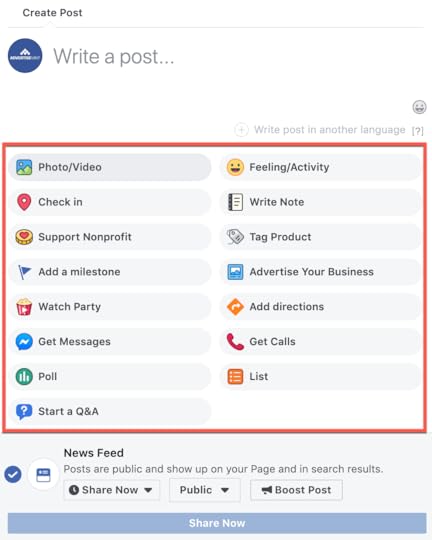 Facebook post options include polls, Q and As, and lists.
Facebook post options include polls, Q and As, and lists. Make Your Page a Community Hub
Users typically like to share their thoughts on Facebook. Invite them to do so on your page by creating posts that spark discussions relevant to your industry. For example, you can host weekly chats or Q-and-A sessions that users can participate in, either to learn new information or share their insights on the given topic. Take it a step further and have a different theme for each session.
Let’s say you’re a professional photographer. Each week, you could share a live stream, demonstrating different camera techniques and tricks of the trade, with the opportunity for users to ask questions. One week the theme may be shutter speed and another week lighting. There are a number of different ways to encourage discussions on your page, other than just sharing marketing messages.
Use Facebook Live
Facebook Live is another way to reach your followers. Each time you go Live, your followers will receive a push notification, unless they turned that off in their Settings. Live streaming gives you the opportunity to be completely transparent with your audience, who see your business as it is, without the polished bells and whistles. Since users are more engaged with live video, Facebook considers it a meaningful interaction, boosting your appearance in News Feeds.
Here are some examples of the ways you can use live video:
Broadcast a business eventShare behind-the-scenes footageDemonstrate how a product works Hold a Q-and-A sessionAsk your audience for feedback about a product or service
The idea behind live video is to establish a sense of community. It’s certainly worth experimenting with to improve your organic reach.
Promote Your Page on Other Social Networks
To increase your engagement, you can also try increasing your page followers. Use other social networks for your business, such as Instagram, LinkedIn, or Twitter, to let your followers know you’re on Facebook, too. Of course, don’t flood your posts on these platforms with links to your Facebook page. Rather, include a link to your page in the bio sections. It’s a subtle way to let people know you’re on Facebook as well.
Share Only High-Quality Images and Videos
Cheesy stock photos are not going to perform well, and they certainly won’t improve your organic reach. Low-resolution or corny videos won’t help either. If you want your photos or videos to perform well, take the time to make sure they’re high-quality and visually pleasing.
Think about the type of visuals that would make you stop scrolling through your feed and pique your interest. You don’t want visuals that will blend in with other content, or even worse, make users stop for a moment to shake their heads at the unprofessional look of your post before continuing to scroll.
Pretend, for a second, that you run a pizza restaurant, and you’re considering posting one of these two images to promote your latest item on the menu. You might consider posting the second image rather than the first image for various reasons.
 Image Courtesy of Pexels
Image Courtesy of Pexels Image Courtesy of Pixabay
Image Courtesy of PixabayThe first image is clearly taken by an amateur. The flash is reflected in the wall, the room is poorly lit, the background is distracting and unprofessional, and the man’s eyes are glowing red from the flash. The man is also clearly posing for the picture, with a cheesy and obviously artificial grin. You can’t see the advertised item, the pizza, which defeats the purpose of the post. The second photo, in contrast, looks far more professional and appealing. This high resolution image is beautifully framed at a unique angle that shows the pizza’s texture, detail, and complementary bright colors.
The second photo will likely perform better because it will stand out in users’ feeds. It grabs their attention and shows your business’s effort in maintaining a good brand image, adding a level of credibility.
Similarly, videos should use captivating footage. At no point should the viewer think the video could have been made in a basement with an old smartphone. Take the time to make your videos look good. When they look good, followers want to engage with them.
Of course, that’s not to say you have to invest in expensive photographers or videographers. You can still use a smartphone to create visual content as long as you pay attention to the quality and performance of your posts.
Post When Your Audience Is Most Engaged
So you’ve crafted the perfect content to post. The quality of your post doesn’t matter if you publish it at 4 a.m., when your target audience is still fast asleep. The result: your post quickly gets lost in the shuffle of News Feed content.
Every follower is different. Experiment with the times of day you post and use your page’s Insights tab to identify when your followers are the most active. To view the times of day your followers are online, select “Posts” from the left-hand column. Facebook will then show you that analytical data.

Once you’ve identified when your followers are most active, schedule posts to publish at those times to increase your reach and opportunities for engagement. Facebook’s algorithm will note the engagement on your post and subsequently prioritize it in your followers’ feeds.
Post Consistently
How often you post is also an influential factor in your organic reach. Experiment with how frequently you post each day and use Facebook’s analytics to see how it affects your reach. You may find that your audience engages with your content when you only post four times a day but loses interest when you post 10 times a day. However, depending on your followers, the opposite could also be true: your reach may be better when you post more times daily. That’s why it’s important to know what makes your followers tick.
Once you’ve pinned down the post frequency that delivers the best reach, stick with it each week. Continue to track your analytics in case your followers’ behavior changes then adjust accordingly. Always remain consistent with what proves most successful.
Refrain from Posting Engagement Bait
It may be tempting to use manipulative means to generate more engagement on your posts. One tactic is known as engagement bait. For example, posts with messages like “Tag a friend who owes you pizza,” or anything that uses trickery to get users to like, comment, vote, share, or tag in the comments section would be engagement bait.
 Example of engagement bait, courtesy of Facebook Newsroom
Example of engagement bait, courtesy of Facebook NewsroomFacebook discourages engagement bait because it does not create meaningful connections. As a result, Facebook pushes your posts to the bottom of News Feed or removes it as spam. Resist the temptation to post engagement bait. Put the work in to create quality, organic content, and it will pay off.
Repurpose Successful Content
If you have a few posts that performed well, keep them in your back pocket. Then, after an adequate amount of time has passed, repost them. As long as they’re not tied to a day, time, or event that is no longer relevant, they can still be used. If your followers enjoyed the post the first time, they will likely enjoy it again.
Even posts that were not quite as successful can be repurposed. You can make slight adjustments, such as rewording the text or changing the image, to see if a post performs better the second time around. You may be surprised at what a minor change can do.
Get Facebook Verified
You may have noticed on other pages a blue or gray badge next to the page name. This is a verification badge, which tells users that the page isn’t fake, that it is owned by the brand, organization, or public figure. Having a verification badge helps distinguish your page from those with similar names that try to pose as your business to lure users in. There are two major perks of the verification badge. First, it establishes trust that your page is authentic, and second, it pushes your page higher in search results.
 Gray verification badges are given to business pages while blue badges are given to public figures.
Gray verification badges are given to business pages while blue badges are given to public figures.In order to verify your page, you need to make sure it is complete. Fill out the “About” section in full, create an official name for your page, upload both a profile and a cover photo, adhere to Facebook’s terms of service, and post regularly. You also need to formally submit a request for verification once all of the aforementioned required steps are met.
Invite Followers to Turn on Notifications for Your Page
A loophole around Facebook’s algorithm is to outright invite your audience to turn on notifications for your page. Doing so ensures that any time you post, the content will be prioritized in your followers’ feeds.
To follow your page, users must click “Following.” From there, they can choose how they want to prioritize your content. If you’re lucky, they will choose “See First” under “In Your News Feed,” placing your newly posted content at the top of their News Feed every time.

Make Sure All Links Lead to Quality, Fast-Loading Sites
There’s nothing worse than going on a poor-quality site that takes forever to load. Before including a link in a post, make sure it directs users to a high-quality site that doesn’t make them sit around, waiting. Otherwise, fewer followers will engage with your content, which Facebook will determine to mean that your content belongs at the bottom of News Feed.
Share User-Generated Content
Users tend to be drawn to content that’s made by other users. When one user creates content for you to share, other users see that you are a business or brand that other users trust. As a result, your engagement levels and organic reach may increase.
Whether it’s video, photos, or reviews, invite your followers to create content for your page. You can do so in the form of contests, hashtag campaigns, or simply inviting users to write a review about their experience with your business. Then, share the best content that comes in.
Use a Balance of Organic Posts and Ads
While it’s certainly important, you shouldn’t rely on organic reach alone. Use a balance of both organic content and Facebook ads on the platform. Facebook ads offer valuable targeting and ad options that can boost your business and generate conversions. Running Facebook ads in addition to organic posts is the best way to reach your followers. If you’re having trouble working it all out on your own, a Facebook advertising agency can always help.
By balancing your Facebook campaign between organic content and ads, your audience won’t be walking past you like a disinterested customer in a grocery store. They’ll be stopping in their tracks and giving you their undivided attention.
The post How to Increase Organic Reach on Facebook appeared first on AdvertiseMint.
Facebook Organic Reach: What It Is and How to Make It Better

Anna Hubbel | Jun. 10, 2018
 Rawpixel / Pexels
Rawpixel / PexelsWhen marketers say “organic,” they’re not referring to those expensive products in the produce section. Instead, they’re referring to organic reach on Facebook. Organic posts are content you share on your page or Timeline for free. Status updates, videos, live streams, and photos are a few examples of organic posts.
Other than the call-to-action button that appears on the ad, one feature that differentiates a sponsored post (Facebook ad) from an organic post is the presence of a “Sponsored” or “Paid Sponsorship” label. Facebook ads are labeled as sponsored while organic posts are not.
 The organic post (left) doesn’t contain a “paid” or “sponsored” label while the ad (right) does.
The organic post (left) doesn’t contain a “paid” or “sponsored” label while the ad (right) does.Organic posts also don’t appear to a chosen target audience. You share posts to your Timeline, hoping your followers see them. This makes organic reach so difficult to increase: you don’t have access to all the audience targeting tools available with Facebook ads. You simply craft a good post, publish at the time of day your audience is most active, and keep your fingers crossed. As if reaching users with organic posts isn’t hard enough, Facebook organic reach has been declining as of late, making it even more of a challenge. There are two main reasons for this.
First, Facebook has become a highly competitive platform for both ads and organic content. As of April 2019, Facebook has 2.38 monthly active users. Back in November 2017, Facebook announced that the platform had more than six million advertisers. That’s a lot of people producing content on the platform. The result: a clogged up News Feeds full of content that pushes your organic posts to the bottom of the feed. Organic posts that are seen by their intended audiences are typically there-and-gone in a flash.
Second, Facebook updated the algorithm in 2018 to prioritize posts by friends and families over posts by brands, publishers, and advertisers. Reaching friends and family organically is already difficult for regular Facebook users, but it is even more of a challenge for those with business accounts. With the update to the algorithm, Facebook users—both business account holders and regular accounts holders—must pay to play.
How Facebook Advertising Increases Your Reach
With both the high demand for News Feed space and the new version of the algorithm, organic reach is very difficult to achieve for businesses. If you invest in Facebook ads, it’s still a challenge; however, the various tools and features Facebook has available for its advertisers makes it easier to reach your audience.
For example, Facebook offers a number of ad targeting options that help you reach the right audience. You can target users based on location, age demographics, device, interests, and behaviors. These targeting options allow you to serve your ads to users most likely to be interested in your business. Facebook advertising also gives you ad objectives to choose from. If, for instance, you want to run a campaign promoting your app to get more downloads, you could choose the app installs objective. With this objective, your ad will appear to users most likely to download your app.
Additionally, Facebook advertising offers a variety of different ad formats and bidding options, allowing you to be creative with your content at a cost you can afford. Your ad format options include video, single image, carousel, and Instant Experience.
Although Facebook advertising certainly helps you achieve your business goals, you shouldn’t give up on organic reach. There’s still value in posting organic content, and it’s still possible to increase your exposure on the platform. You just have to work a little harder.
Tips for Improving Your Facebook Organic Reach
To improve your organic reach on Facebook, you must first understand how the algorithm works. To determine which post appears on top of users’ feeds, the algorithm gives each post a score, and this score is determined by three factors: the person who published the post, the type of post, and the post’s engagement numbers. A highly ranked Facebook post is published by an account with which users often interact, and it is the type of format (for example, image versus video) users most often engage with. Engagement numbers also boosts a post’s rank.
With Facebook’s algorithm in mind, there are a number of different ways to increase your reach without paying for Facebook ads.
Use a Variety of Post Formats
To increase your engagement, try increasing your post variety. Contrary to what you might think, your posts aren’t limited to text, images, and videos. In fact, there are several formats you can use. When writing a post, look at Facebook’s list of post types. You can view the full list by clicking the three-dotted menu icon.
 More Facebook post options can be accessed by clicking the three-dotted menu.
More Facebook post options can be accessed by clicking the three-dotted menu. In addition to adding images and videos to your posts, you can also tag products, support a nonprofit, create a poll, check in at a location, add a feeling or activity, add a “Send Message” call-to-action button, and even invite users to join a Watch Party on your page. Experiment with these different post types to engage with your audience in creative ways and to increase post diversity, keeping your content from becoming stale. The more interesting and diverse your posts, the more engagement you can obtain. As you try different post formats, keep track of their performance. This will help you determine which post resonates with your followers the most.
 Facebook post options include polls, Q and As, and lists.
Facebook post options include polls, Q and As, and lists. Make Your Page a Community Hub
Users typically like to share their thoughts on Facebook. Invite them to do so on your page by creating posts that spark discussions relevant to your industry. For example, you can host weekly chats or Q-and-A sessions that users can participate in, either to learn new information or share their insights on the given topic. Take it a step further and have a different theme for each session.
Let’s say you’re a professional photographer. Each week, you could share a live stream, demonstrating different camera techniques and tricks of the trade, with the opportunity for users to ask questions. One week the theme may be shutter speed and another week lighting. There are a number of different ways to encourage discussions on your page, other than just sharing marketing messages.
Use Facebook Live
Facebook Live is another way to reach your followers. Each time you go Live, your followers will receive a push notification, unless they turned that off in their Settings. Live streaming gives you the opportunity to be completely transparent with your audience, who see your business as it is, without the polished bells and whistles. Since users are more engaged with live video, Facebook considers it a meaningful interaction, boosting your appearance in News Feeds.
Here are some examples of the ways you can use live video:
Broadcast a business eventShare behind-the-scenes footageDemonstrate how a product works Hold a Q-and-A sessionAsk your audience for feedback about a product or service
The idea behind live video is to establish a sense of community. It’s certainly worth experimenting with to improve your organic reach.
Promote Your Page on Other Social Networks
To increase your engagement, you can also try increasing your page followers. Use other social networks for your business, such as Instagram, LinkedIn, or Twitter, to let your followers know you’re on Facebook, too. Of course, don’t flood your posts on these platforms with links to your Facebook page. Rather, include a link to your page in the bio sections. It’s a subtle way to let people know you’re on Facebook as well.
Share Only High-Quality Images and Videos
Cheesy stock photos are not going to perform well, and they certainly won’t improve your organic reach. Low-resolution or corny videos won’t help either. If you want your photos or videos to perform well, take the time to make sure they’re high-quality and visually pleasing.
Think about the type of visuals that would make you stop scrolling through your feed and pique your interest. You don’t want visuals that will blend in with other content, or even worse, make users stop for a moment to shake their heads at the unprofessional look of your post before continuing to scroll.
Pretend, for a second, that you run a pizza restaurant, and you’re considering posting one of these two images to promote your latest item on the menu. You might consider posting the second image rather than the first image for various reasons.
 Image Courtesy of Pexels
Image Courtesy of Pexels Image Courtesy of Pixabay
Image Courtesy of PixabayThe first image is clearly taken by an amateur. The flash is reflected in the wall, the room is poorly lit, the background is distracting and unprofessional, and the man’s eyes are glowing red from the flash. The man is also clearly posing for the picture, with a cheesy and obviously artificial grin. You can’t see the advertised item, the pizza, which defeats the purpose of the post. The second photo, in contrast, looks far more professional and appealing. This high resolution image is beautifully framed at a unique angle that shows the pizza’s texture, detail, and complementary bright colors.
The second photo will likely perform better because it will stand out in users’ feeds. It grabs their attention and shows your business’s effort in maintaining a good brand image, adding a level of credibility.
Similarly, videos should use captivating footage. At no point should the viewer think the video could have been made in a basement with an old smartphone. Take the time to make your videos look good. When they look good, followers want to engage with them.
Of course, that’s not to say you have to invest in expensive photographers or videographers. You can still use a smartphone to create visual content as long as you pay attention to the quality and performance of your posts.
Post When Your Audience Is Most Engaged
So you’ve crafted the perfect content to post. The quality of your post doesn’t matter if you publish it at 4 a.m., when your target audience is still fast asleep. The result: your post quickly gets lost in the shuffle of News Feed content.
Every follower is different. Experiment with the times of day you post and use your page’s Insights tab to identify when your followers are the most active. To view the times of day your followers are online, select “Posts” from the left-hand column. Facebook will then show you that analytical data.

Once you’ve identified when your followers are most active, schedule posts to publish at those times to increase your reach and opportunities for engagement. Facebook’s algorithm will note the engagement on your post and subsequently prioritize it in your followers’ feeds.
Post Consistently
How often you post is also an influential factor in your organic reach. Experiment with how frequently you post each day and use Facebook’s analytics to see how it affects your reach. You may find that your audience engages with your content when you only post four times a day but loses interest when you post 10 times a day. However, depending on your followers, the opposite could also be true: your reach may be better when you post more times daily. That’s why it’s important to know what makes your followers tick.
Once you’ve pinned down the post frequency that delivers the best reach, stick with it each week. Continue to track your analytics in case your followers’ behavior changes then adjust accordingly. Always remain consistent with what proves most successful.
Refrain from Posting Engagement Bait
It may be tempting to use manipulative means to generate more engagement on your posts. One tactic is known as engagement bait. For example, posts with messages like “Tag a friend who owes you pizza,” or anything that uses trickery to get users to like, comment, vote, share, or tag in the comments section would be engagement bait.
 Example of engagement bait, courtesy of Facebook Newsroom
Example of engagement bait, courtesy of Facebook NewsroomFacebook discourages engagement bait because it does not create meaningful connections. As a result, Facebook pushes your posts to the bottom of News Feed or removes it as spam. Resist the temptation to post engagement bait. Put the work in to create quality, organic content, and it will pay off.
Repurpose Successful Content
If you have a few posts that performed well, keep them in your back pocket. Then, after an adequate amount of time has passed, repost them. As long as they’re not tied to a day, time, or event that is no longer relevant, they can still be used. If your followers enjoyed the post the first time, they will likely enjoy it again.
Even posts that were not quite as successful can be repurposed. You can make slight adjustments, such as rewording the text or changing the image, to see if a post performs better the second time around. You may be surprised at what a minor change can do.
Get Facebook Verified
You may have noticed on other pages a blue or gray badge next to the page name. This is a verification badge, which tells users that the page isn’t fake, that it is owned by the brand, organization, or public figure. Having a verification badge helps distinguish your page from those with similar names that try to pose as your business to lure users in. There are two major perks of the verification badge. First, it establishes trust that your page is authentic, and second, it pushes your page higher in search results.
 Gray verification badges are given to business pages while blue badges are given to public figures.
Gray verification badges are given to business pages while blue badges are given to public figures.In order to verify your page, you need to make sure it is complete. Fill out the “About” section in full, create an official name for your page, upload both a profile and a cover photo, adhere to Facebook’s terms of service, and post regularly. You also need to formally submit a request for verification once all of the aforementioned required steps are met.
Invite Followers to Turn on Notifications for Your Page
A loophole around Facebook’s algorithm is to outright invite your audience to turn on notifications for your page. Doing so ensures that any time you post, the content will be prioritized in your followers’ feeds.
To follow your page, users must click “Following.” From there, they can choose how they want to prioritize your content. If you’re lucky, they will choose “See First” under “In Your News Feed,” placing your newly posted content at the top of their News Feed every time.

Make Sure All Links Lead to Quality, Fast-Loading Sites
There’s nothing worse than going on a poor-quality site that takes forever to load. Before including a link in a post, make sure it directs users to a high-quality site that doesn’t make them sit around, waiting. Otherwise, fewer followers will engage with your content, which Facebook will determine to mean that your content belongs at the bottom of News Feed.
Share User-Generated Content
Users tend to be drawn to content that’s made by other users. When one user creates content for you to share, other users see that you are a business or brand that other users trust. As a result, your engagement levels and organic reach may increase.
Whether it’s video, photos, or reviews, invite your followers to create content for your page. You can do so in the form of contests, hashtag campaigns, or simply inviting users to write a review about their experience with your business. Then, share the best content that comes in.
Use a Balance of Organic Posts and Ads
While it’s certainly important, you shouldn’t rely on organic reach alone. Use a balance of both organic content and Facebook ads on the platform. Facebook ads offer valuable targeting and ad options that can boost your business and generate conversions. Running Facebook ads in addition to organic posts is the best way to reach your followers. If you’re having trouble working it all out on your own, a Facebook advertising agency can always help.
By balancing your Facebook campaign between organic content and ads, your audience won’t be walking past you like a disinterested customer in a grocery store. They’ll be stopping in their tracks and giving you their undivided attention.
The post Facebook Organic Reach: What It Is and How to Make It Better appeared first on AdvertiseMint.
June 3, 2019
Sponsored Posts vs Facebook Ads. What’s the Difference?

By Anna Hubbel | Jun. 3, 2018
 Bruce Mars / Pexels
Bruce Mars / PexelsDo you ever get a suggestion from Facebook to boost a post on your page and wonder about the difference between a sponsored post and a Facebook ad? Turns out there is quite a difference. Although both Facebook ads and sponsored posts are paid ways to deliver your content to your audience, one is a more condensed version of the other, with fewer features and capabilities. However, both can help achieve your goals, depending on your business’s needs.
This article will explain the difference between sponsored posts and Facebook ads and the potential benefits and limitations of each to help you choose the best option for your business.
What Are Sponsored Posts?
Sponsored Facebook posts, also known as boosted posts, are organic posts you pay to show to a wider audience. You can only boost an organic post you published on your Facebook page, which will only appear to your page followers. However, when you boost that organic post, you can choose your target audience and serve that post to people beyond your page followers.
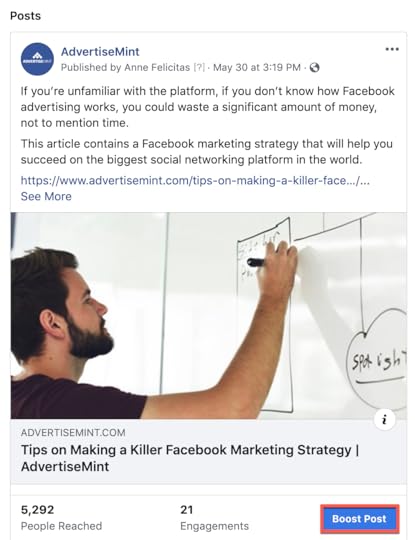 The option to boost a post appears as a blue button on the lower-right corner of the post.
The option to boost a post appears as a blue button on the lower-right corner of the post. Facebook typically suggests boosting a post if it’s performing well on your page or if other businesses have boosted similar content. If you choose to boost your post, you can specify your target audience, budget, and duration of the promotion. You and any other admins for your page have the ability to boost a post as long as you have access to your page’s ad account.
How to Boost a Post
Step 1: Click the blue “Boost Post” button located on the lower-right corner of the post.

Step 2: Choose your objective.

You have three options:
Send people to your website: You post will appear to people who are most likely to click on your post to visit your website. Once clicked, the ad will send your target audience to your chosen landing page. Get more people to react, comment, and share: Your post will appear to audiences most likely to engage with your content. Connect and chat with potential customers: Your post, once clicked, will open a Messenger conversation between you and your target audience.
Step 3: Choose your post button.
Make sure that the call-to-action button matches the action you want your target audiences to take and the landing page where the ad will redirect them. For example, if you choose the “connect and chat” objective and Messenger as your landing page, you must choose the most relevant post button from the list, which is the “Send Message” button. If you choose the “send people to your website” objective and your product catalog as your landing page, then “Shop Now” is the appropriate button to use.

Step 4: Choose your audience.
Your audience will be the group of Facebook users who will see your post. You can choose an audience based on location, age, and connections. You can even upload a Custom Audience.

Step 5: Choose your placements and budget.
Your chosen placements will be where your boosted post will appear. If you choose to automatically place your post, it will appear on Facebook, Messenger, and Instagram. If you don’t like the automatic placement options, you can choose to turn off automatic placements and manually choose the options where you want your post to appear. For your budget, you can enter whatever amount you want to spend for the duration you want the ad to run.

Step 6: Turn on your Facebook Pixel
To turn on your Facebook Pixel, slide the toggle button to the right. This step is important because the pixel will track your target audience’s behavior and retarget those who interacted with your ad but did not convert.

The Good
There are two benefits to using a boosted post. For one, it helps acquire as many engagements as possible for that one post. This helps with raising brand awareness and increasing page followers. This also helps with social proof for your brand. Users will see how many users are interacting with your content, and they will want to see what the fuss is about.
Another nice perk is the ability to specify your target audience. You can target users by location, age range, and interests. If you want to reach more users on Instagram, you can choose to run your promotion on that platform as well.
If you’re completely new to Facebook advertising, sponsored posts are a great way to start, especially if you do not yet have a large budget to invest in ad creative.
The Not-So-Good
One downside to sponsored posts is you can’t get creative with different formats. When you boost a post, it’s delivered as is. You don’t have the ability to create it as a Carousel, Canvas, or Lead, ad. Sponsored posts are much more limiting in formats than Facebook ads.
Another downside is you only have three objectives to choose from: engagement, website clicks, and Messenger. If you want to drive foot traffic to your physical store, increase app downloads, or gain more subscriptions, for instance, you wouldn’t be able to customize your boosted post to do so.
Additionally, sponsored posts do not allow you to enable bidding, and you also have a limited number of placement options. Manual bidding lets you specify a maximum average bid or a maximum per-bid rate, as well as choose whether you want to pay for impressions, clicks, or other options. As for placements, the only placement options you have for sponsored posts are Facebook News Feed and Instagram. Facebook ads give you more placements to choose from (more on those later).
When to Use Sponsored Posts
Although somewhat limited, sponsored posts are beneficial for some circumstances, particularly when you want to spread brand awareness and generate social proof. Here are some circumstances in which a sponsored post is the way to go:
You want to make a big announcement.You want to promote an upcoming event to both create social proof and increase attendance to the event. You have user-generated content on your Page that can gain customer trust and garner new followers.
What Are Facebook Ads?
 Kaboompics.com / Pexels
Kaboompics.com / PexelsFacebook ads are different from sponsored posts because they involve more strategic planning and give you more creative flexibility, targeting options, and performance data. When you want to create a more polished, professional, and refined campaign, Facebook ads are the way to go.
The Good
There are a number of reasons why Facebook ads can be beneficial for your business. For one, unlike sponsored posts, Facebook ads give you more objectives to choose from to make sure your campaign delivers the results you want. While sponsored posts only have engagement, Messenger, and website traffic objectives, Facebook ads include those two objectives as well as the following:
Store trafficConversionsCatalog salesLead generationVideo viewsApp installsBrand awarenessReach
These objectives give you more options to achieve your business goals. For example, if you want to get more people to download your app, the app installs objective will help you create ads geared toward this goal. Facebook will then help you deliver your ads to users most likely to download your app. Similarly, if you want to generate leads for your business, you can use the lead generation objective to deliver ads that collect leads from your target audience.
Facebook ads also allow you to choose from a variety of placement options. Whereas sponsored posts only let you choose Facebook News Feed and Instagram for placements, ads give you the additional placement options of the following:
MarketplaceRight ColumnSuggested VideosFacebook StoriesFacebook Instant ArticlesInstagram StoriesInstant ArticlesMessengerAudience NetworkFacebook In-Stream Videos
These placements give you more ways to reach users, ensuring that your message is being delivered in the most optimal way for your campaign goals. You can specify whether you want your ads to be delivered to mobile users only, desktop users only, or across all devices.
Facebook ads also allow you to implement more refined audience targeting. In addition to the basic targeting options, such as by age, location, and gender, you can overlap other customizations. For example, you can add targeting based on interests, behaviors, and demographics. You can also upload a Custom Audience or create a Lookalike Audience. A Custom Audience is created from a list of leads you’ve already collected that you can upload to Facebook. Facebook then uses that information to deliver your ads to users on that list. A Lookalike Audience delivers ads to new users who look similar to your Custom Audience.
With Facebook ads, you can also use in-depth manual bidding. You can specify a maximum average bid or a maximum per-bid rate, and whether you want to pay for impressions, clicks, or other options. The ability to enable manual bidding is especially useful if you want to scale your Facebook ads.
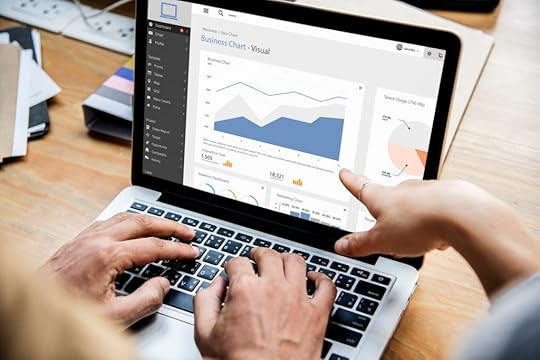
Image Courtesy of Pexels.com
Another benefit of Facebook ads is the access you have to in-depth tracking and campaign metrics. For example, you can install the Facebook Pixel on your website to track users’ activity on your website in relation to a Facebook ad they clicked. This helps you learn how your audience is interacting with your ads, as well as determine whether your ads are generating your desired results. Additionally, Facebook announced last year that it was simplifying its ad metrics with new labels, making it easier than ever to understand your campaigns.
Last but not least, perhaps the best reason to use Facebook ads is the variety of ad formats you can use, including Carousel Ads, Canvas Ads, Stories, video, and articles. Users easily get tired of seeing the same ads over and over. Facebook ads make it possible to deliver the same message in a variety of different ways to keep your audience interested and feeling like they’re seeing brand new content. As a result, your business looks more polished, credible, and creative.
The Not-So-Good
It terms of effectiveness, there are very few downsides to using Facebook ads. However, if you have a limited budget, and you can’t use Facebook ads in regular campaigns, they may not (yet) be the approach for you. Additionally, Facebook advertising is a complex system; it can be challenging to understand performance metrics and to create the most effective ads for your specific business. If you are unfamiliar with the system, you could waste a lot of money on a failed campaign.
To ensure any campaign with Facebook ads is successful, hire a Facebook advertising agency. Although you should always familiarize yourself with the process before diving in, an agency already knows the ins and outs. It is the ultimate time-saver if you need to focus on other areas of your business.
When to Use Facebook Ads
Most of the time, Facebook ads are the preferred choice over sponsored posts. The benefits are always well worth the investment, and there is far more flexibility. Below are some of the reasons to use Facebook ads:
You want more creative options.You have a specific audience you want to target.You want to acquire new customers.You want to reach existing customers.You want access to detailed campaign metrics.You want to use the Facebook Pixel.You have a very specific campaign objective.You want to access to more placements.You want to use manual bidding.
If planned well, marketing with Facebook ads can help you achieve low cost per acquisition (CPA) or cost per click (CPC). Again, one of the best ways to keep your costs low and results successful is to consider hiring a Facebook advertising agency.
The Choice Is Up to You
 NESA by Makers / Unsplash
NESA by Makers / UnsplashEvery marketing decision requires a full understanding of the pros and cons involved before making the investment. When it comes to Facebook advertising, the possibilities are extensive. If you’re trying to decide whether you should go with sponsored posts or Facebook ads, consider the benefits and limitations of each discussed in this article and weigh them with your specific business’s needs and financial situation. You may find that incorporating both into your overall Facebook marketing strategy works best for your business. Don’t be afraid to experiment (within reason, of course). You never know just how great the results can be until you try.
Written by Anne Hubbel , writer at AdvertiseMint
The post Sponsored Posts vs Facebook Ads. What’s the Difference? appeared first on AdvertiseMint.
May 30, 2019
Tips on Making a Killer Facebook Marketing Strategy

By Anna Hubbel | May 30, 2018
 Raw Pixel / Pexels
Raw Pixel / PexelsMarketing is so much different now than it used to be. Most campaigns are digital, with social media as the biggest channel for delivering ads to audiences. Facebook in particular has helped many businesses succeed, but if you’re unfamiliar with the platform, if you don’t know how Facebook advertising works, you could waste a significant amount of money, not to mention time. This article contains a Facebook marketing strategy that will help you succeed on the biggest social networking platform in the world.
Be Specific About Your Business Goals
If you’re turning to Facebook to market your business, you need to know exactly what you want out of it in order to measure whether or not the platform is working for you. Think about your business goals with your marketing team or Facebook advertising agency, and write down what you want to accomplish: Do you want to increase sales, boost brand awareness, drive app installs?
Facebook’s numerous ad objectives will help you achieve your business goals. These objectives fall under three of the following categories.
Awareness: generates interest in your business’s offeringsConsideration: gets users thinking about your businessConversions: encourages users to buy your product or service
Awareness
The awareness category includes the following objectives:
Brand awareness: spreads the word about your brand so more people know about itReach: reaches as many users who match your target audience as possible
Consideration
The consideration category includes
Traffic: drives visits to your website or appApp installs: directs users who click on your ad to the app store to download your appEngagement: increases the number of users who see and engage with your Facebook page content, such as posts and events Video views: gets more users to watch your Facebook videosLead generation: acquires new leads by collecting customer information, such as email addresses, first and last names, and phone numbersMessages: encourages more users to engage in conversations with your business on Facebook Messenger
Conversions
The conversions category includes the following:
Conversions: prompts more customers, new or existing, to purchase on your website, subscribe to your mailing list, download your app, or make other conversions relevant to your business goalsCatalog sales: promotes items from your product catalog that are relevant to your target audienceStore visits: drives foot traffic to your business’s brick-and-mortar location
By clearly identifying your objectives, it’ll be easier to craft ads and organic content that best fit your needs, which will more likely result in a successful Facebook campaign.
Determine Who Is Your Target Audience
 Mentatdgt / Pexels
Mentatdgt / PexelsNo Facebook content, organic or paid, is going to perform well if it’s delivered to an audience unlikely to engage. A hardcore rock-and-roller, for instance, probably won’t buy your opera album, so promoting your CDs to this individual isn’t going to deliver the conversions you’re aiming for. You should be able to answer the following questions to determine who is your target audience.
What are their key interests? For example, if you’re promoting a romantic comedy, your ideal audience includes users who enjoy movies, romance, and comedy.Where do they live? If your business is entirely online, your target audience may live anywhere. However, if you’re trying to reach locals to drive foot traffic, specify a geographical radius. Other factors, such as seasonal influences, may also determine the location of your target audience.What age demographic do you want to reach? Do you want to reach millennials, gen Zs, or parents?Does your target audience have a specific range of income? If you offer expensive products or services, you don’t want to deliver your ads to an audience that may not be willing to spend too much money.Is education a factor? For example, if you sell college supplies, your target audience may be recent high school graduates.
Other factors may also be important to know, depending on the product or services you offer and your objectives. Add any relevant questions to the above list and be as specific as possible. Knowing everything you can about your target audience will help you deliver relevant content to people who are most inclined to respond.
If you’ve already accumulated a list of customer leads, you can upload it to Facebook as a Custom Audience. Facebook will use that information to deliver your ads to users who have already interacted with your business in some way. But be aware of Facebook’s latest efforts to be more transparent with users about advertisers who target them with Custom Audiences.
To reach new customers, you can use your Custom Audience to create a Lookalike Audience, which targets users with similar interests and demographics to those of your Custom Audience. This ensures your ad will be delivered users who are likely to interact with your business.
Set a Realistic Budget
 Pixabay / Pexels
Pixabay / PexelsIf you aren’t careful, you can end up spending a lot of money on Facebook ads. However, when appropriated wisely, the money invested in marketing on the platform is money well spent.
Just as you need to be very specific about your objectives and target audience, you want to be specific about where your money will go. For example, you want to budget for the promotion of the ads, as well as the creative process behind them. Facebook doesn’t charge you to create content, but you may determine that you want to invest in a Facebook advertising agency. Create a budget for any portion of your Facebook marketing plan that you are willing to invest in.
Depending on the size of your business, your budget will vary. Be realistic and crunch the numbers. You may want to get a financial expert to help you accurately calculate the costs.
Create Engaging Organic Content
To give your Facebook page more value to users, you want to post engaging organic content. The more engaging it is, the more users will interact with it, the more Facebook will prioritize your posts in users’ News Feeds. You should also diversify your content to make it more interesting and to avoid boring your audience with your posts. Alternate between video, images, and Gifs, as visuals grab your audience’s attention more than just plain text.
When choosing visuals for your posts, make sure they are high-resolution and professional. Anything less will make your page seem inexperienced and behind the times. Additionally, avoid cheesy stock photos. Images should always be relevant to your message, and they should look both natural and stunning. Look at the following two stock photos, for example.
 Pexels
PexelsWhich stock photo looks more natural? Hopefully, you agree that the photo on the right is more captivating and natural than the one on the left. The photo on the left looks very staged, with people that appear stiff and fake. The photo on the right, however, looks like a real workplace environment, due to the candid shot and natural appearances of the subjects in the image.
With video, since most users will be watching it with sound off on their mobile devices, you need to make your message clear even without audio. Use captions to convey your message. Still, your video’s audio should also be high-quality, so users who do watch it with sound on can hear everything crystal clear.
When writing your post text, be interesting, and make sure it is free of common grammatical errors. To encourage users to engage with your posts, ask questions, ask for their thoughts, educate them, or tap into their emotions. Be wary of lazy copywriting. You never want your audience to lose interest.
Create Engaging Ads
As you would with organic content, you need to create high-converting and engaging Facebook ads. Otherwise, you will fail to meet your business’s objective. The approach is similar to creating organic content. You want to include engaging and high-quality visuals that are relevant to the message. The video you post should include captions, and the copy should be compelling. However, there are more factors to consider when creating click-worthy ads that drive desired conversions. With Facebook ads, you want to add a value proposition, CTA (call to action), and social proof to your creatives.
 Value propositions provide the benefit of purchasing a product or service. Ad taken from Facebook’s Ad Library
Value propositions provide the benefit of purchasing a product or service. Ad taken from Facebook’s Ad LibraryValue proposition conveys the benefit of the product or service you’re promoting. It gives your customers incentive to take action. A value proposition could be a solution to a problem, a discount or special offer, or a reason why customers should buy from you, not your competitors.
 All Facebook ads contain CTA buttons. Ad taken from Facebook’s Ad Library
All Facebook ads contain CTA buttons. Ad taken from Facebook’s Ad Library
CTAs are phrases urging your audience to take action. Although you can add CTAs in your ad copy, Facebook ads already include CTA buttons, including those that say “Buy Now,” “Learn More,” “Sign Up,” and “Click Here.” By including CTAs in your Facebook ad, you’re prompting your audience to engage with it.
Social proof gives your audience evidence that others are engaging with your business or taking action on your ad, serving as social media’s “word of mouth.” It can typically be used in your ad’s copy, such as “Thousands of people are raving about this product,” or it can simply appear in the form of likes, shares, and comments on your ad.
 Advertisers often feature customer reviews on ads, which function as social proof.
Advertisers often feature customer reviews on ads, which function as social proof.Another way to make your Facebook ads engaging is to format them for vertical screens. Facebook users spend a lot of time on their mobile devices. They very rarely rotate their phones to watch a video horizontally anymore, so you should optimize your ads for mobile by formatting them vertically. Video ads in particular should be optimized for mobile. You can get creative within the vertical space, directing your audience’s eye throughout the video by using bright colors, movement, or split screens. Play around with your video creative to make it engaging for mobile users.
Engaging ads are the key to conversions. You don’t want to neglect this area of your marketing strategy.
Use a Variety of Ad Formats
The beauty of Facebook advertising is there are so many formats to choose from. There are Carousel Ads, Dynamic Ads, Lead Ads, and Canvas Ads.
 An example of a Carousel Ad
An example of a Carousel AdCarousel Ads allow you to include multiple images and videos in one ad, using a string of carousel cards. You can use the cards to tell a story, demonstrate steps to using a product, or display multiple products you want to promote from your store.
Dynamic Ads advertise products from your product catalog. They help you deliver relevant ads to customers from your target audience who have viewed your product, placed products in their shopping carts, or purchased specific products.
Lead Ads help you collect leads by using a form pre-filled with information the user previously shared with Facebook. They also allow you to create custom questions and conditional answers.
 An example of a Lead Ad
An example of a Lead AdCanvas Ads allow you to create an immersive mobile experience for your audience. This format offers a variety of templates to choose from, depending on what you want to accomplish. For example, the Lifestyle layout lets you build immersive, branded collections with lifestyle imagery in the form of people, places, or experiences.
Post Content When Your Audience Is Most Engaged
Once you’ve gotten to know your audience, you should pay attention to the times of day when they’re the most engaged with your content. Once you’ve identified those key days and times, schedule your content to post at those times. This will increase the likelihood that your audience will engage with your content, helping you drive conversions.
Scheduling tools like Hootsuite make it easy to schedule bulk content. You can plan out your posts for the week or even the month to ensure you’re posting consistently and frequently, keeping your audience engaged when they’re the most active on Facebook.
Use Analytics to Keep Track of Your Campaign’s Performance
How do you know how well your Facebook campaign is performing? Facebook’s Ads Manager offers a variety of metrics to help you measure campaign performance and post reach. Last year, Facebook simplified its ad metrics with new labels, so it’s easier to understand your metrics now more than ever.
If you or the person in charge of your Facebook campaign has trouble understanding Facebook’s metrics, a Facebook advertising agency can help you understand and interpret your results.
Split Test Often
Last but not least, you should regularly split test your Facebook ads. Split testing, also known as A/B testing, is the process of experimenting with different ad elements to find the best performing version of the ad. For instance, you can swap out an image with a new one while keeping the same copy to see whether the ad performs better. Split testing helps you choose the version that will best deliver the results you’re aiming for.
Using Facebook to market your business is a wise decision. However, it does require careful planning and a solid strategy to reach your goals successfully. If you’re new to the game or if you don’t have the time to dedicate to your Facebook marketing plan, you should consider hiring a reputable Facebook advertising agency to help you navigate such a complex platform.
Written by Anne Hubbel , writer at AdvertiseMint
The post Tips on Making a Killer Facebook Marketing Strategy appeared first on AdvertiseMint.
May 24, 2019
What Is Facebook Post Engagement and Why Should You Care

Julia Liu | May 24, 2019
 Joshua Anderson Slate / Pexels
Joshua Anderson Slate / PexelsFacebook engagement is the measurement of users’ interaction with your posts and ads, the likes, comments, and shares that occur. It is the “social” in social media, the reason you work so hard on your content because it indicates that users value your posts. However, if you are posting organic content regularly, and you are also running ads, it can be tricky to keep track of your engaement.
Insights
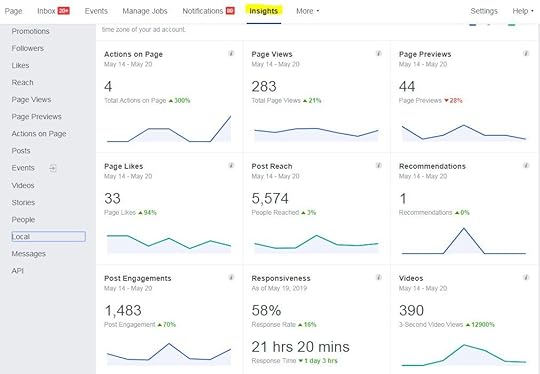
Insights is the place you visit to see your overall post engagment and the quick snapshot of the engagement that has occurred on your page in the last week. You will, for example, be able to see how many new followers you have and how many likes. Although this is great information, it doesn’t help you determine if a specific organic post or boosted post is getting good traction. To see the numbers for a specific post, scroll to the bottom of your Insights page.
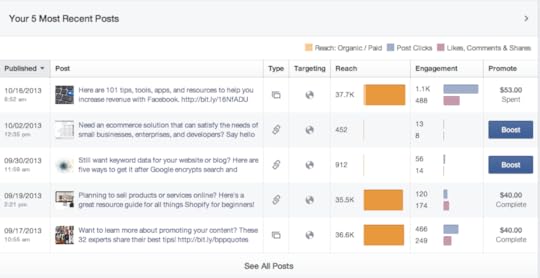 Photo courtesy of NeilPatel.com
Photo courtesy of NeilPatel.comIn this area, you can see how individual posts are performing. Some of these posts are ads, and you can differentiate between the ads and the organic posts by looking at the amount spent under “Promote.” Organic posts have the “boost” button underneath the “Promote” column.
As you can see, the ads have more interaction and engagement than the organic posts. However, not all the ads performed the same. If you wanted to put some more money on one of these ads, which would be the wiser choice? The ad titled “Here are 101 tips, apps…” performed significantly better than the other posts, with 1.1K individual actions taken on it. This particular post resonates with your audience. Take note of the best performing posts when creating content and try to emulate them.
Why Does Any of This Matter?
You’ve been working hard and analyzing your data, but how do you know if any of this is helping your business? I assure you, it is. Have you heard of the Facebook algorithim? The algorithim determines if your organic posts are going to be shown to your audience or not.
You can see the effect of the algorithim on your personal page. For example, I have 400 friends on Facebook, but I only see approximately 40 of them in my News Feed, even though the other 360 friends post regularly.
As I interact with my friends’ posts, Facebook is taking note of whose posts I like and share and whose posts I just skim by. It then makes adjustments based on these observations. It shows me fewer of the posts I skim by and more of the posts from people I interact with. That is, posts that receive a lot of engagement are prioritized in feeds over the posts that do not receive a lot of engagement. Of course, engagement is only one determinant to a post’s prioritization in News Feed. Still, it is an important determinant nonetheless.
How to Increase Your Facebook Post Engagement
In January 2018, Facebook made a major adjustment to its algorithm that affected business pages. In the age of fake news, Facebook reduces the reach posts from businesses, public figures, and publishers while increasing post from users’ friends and family. The latest algorithm favors organic posts from users, especially ones that receive a lot of engagement. This is what businesses are up against. Now more than ever, it is more difficult to get your organic posts before the eyes of your followers. However, there are definite ways to increase engagement on your posts and ensure you are showing up in your followers’ News Feeds.
Videos
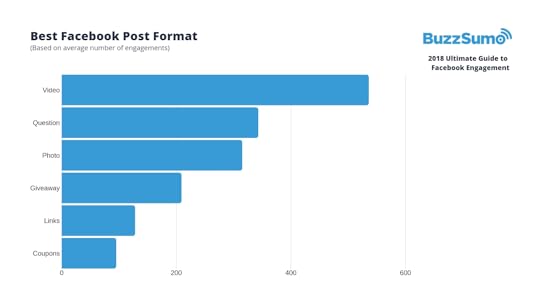 Photo courtesy of BuzzSumo
Photo courtesy of BuzzSumoTo boost your Facebook engagement, first look at the type of content you are producing. Different types of content will garner different levels of engagement from your users. According to BuzzSumo data analysis, video is the clear winner on Facebook. Videos get at least 59 percent more engagement than other posts. Mari Smith, Facebook marketing expert, believes the “optimal ratio for your Facebook posts should be 70 percent videos, 20 percent photos, and 10 percent links.”
Of course, one solution may not work for everyone. For this reason, test your formats and anayze your results. If you find that videos work well for you, then continue producing videos. If posts with static images work better, then continue with static images. Again, try to emulate your best performing posts.
Call to Action
Calls to action are also helpful in increasing engagement because they ask for the user to take a specific action, whether that’s to visit your website or sign up for your newsletter. For example, if you want to post a video, go live on Facebook and ask for your users to sign up for your newsletter. However, don’t confuse call to actions with engagement bait, which Facebook’s algorithm demotes.
Posting Times and Days
Some studies show that the best time to post on Facebook is between 9 p.m. to 8 p.m., EST. Think of parents finally getting their kids to bed, millenials finally finishing their jobs, and teens, who are supposed to be getting ready for bed, surfing the web. That is why more people are on Facebook, interacting with posts during these hours.
But other studies have shown slightly different times or days. The easiest way to determine the best time for you is to experiment and see the times and days that get the most interaction for your posts. That will tell you when your audience is on Facebook.
Don’t Make These Mistakes
 Fox Van Allen / Techlicious
Fox Van Allen / TechliciousEngagement Bait
Just as Facebook rewards relevant content with a good amount of engagement, the algorithim will punish certain types of content. A Facebook post that will get you in trouble is engagement bait. These are posts with message like “Share if your love your mom” or “vote for your favorite house type.” These posts are purely for forcing engagement rather than creating valuable content that users want to interact with. Facebook will push these type of posts down the feed.
 Example of engagement bait, courtesy of Facebook Newsroom
Example of engagement bait, courtesy of Facebook NewsroomRather than posting engagement bait, make your content engaging and relevent to your business. An occasional humorous meme that you tie into your business can add some personality into your page’s Timeline. Useful and informative articles, infographics, and weekly tips may be valuable to your followers.
Don’t Buy Friends
 Mentatdgt / Pexels
Mentatdgt / PexelsIt is possible to buy Facebook likes and followers, and you might be tempted to do it: You’re worried that your business lacks credibility by only having several hundred followers. Buying followers may seem to solve these problems in the short term, but it can cause problems for your page in the long run.
Remember the algorithim? It likes to see interaction with your posts. If you buy 1,000 users, they won’t truly be interested in your product or service. They will not interact with your posts, and your posts will not be prioritized by the algorithim. Even if you boost your posts and put money into reaching your followers, your purchased followers won’t care about you, and that money will be wasted.
Your Facebook engagement shows you how valuable your posts are to your followers. If you want to increase engagement, remember to post valuable and relevant content people can’t help but like and share. Post content that sparks a conversation in the comments section. And when you do post something people love, use it as a guide for your next posts.
Written by Julia Liu, writer at AdvertiseMint.
The post What Is Facebook Post Engagement and Why Should You Care appeared first on AdvertiseMint.



